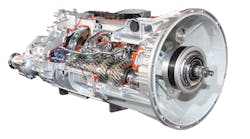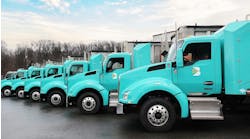It is pretty clear that the future of commercial fleets is moving toward a day when most trucks and vans are electric. What isn’t clear is when that day will fully come. In the meantime, technicians have to stay on top of all the tweaks and trends with conventional transmissions that will continue to show up in the service bay.
“Electric vehicle technology and infrastructure will need to evolve before it can fully support medium- and heavy-duty trucks and buses,” said Branden Harbin, executive director of global marketing at Allison Transmission, referring to battery efficiency and charging stations. “Therefore, conventional solutions will still be necessary for years, if not decades, to come.”
Automated manual transmissions (AMTs) and automatics have already gone through a fair bit of evolution, adding technological improvements that help improve efficiency. OEMs have also been pushing integrated powertrains, where the engine and transmission were designed to offer more power and efficiency together. The latest, Navistar’s S13 Integrated Powertrain for International trucks, features an S13 engine mated to the new T14 (14-speed) AMT to offer a 15% boost in efficiency over the 2017 GHG A26 engine. Part of that efficiency boost comes from the electronically controlled clutch actuator that Navistar said “works in sync with the engine to deliver faster, smoother shift performance.” The system also does not require an air recharge after tight maneuvers, and the integrated oil and water coolant system optimizes temperature regulation in extreme environments. The powertrain is still in the validation phase before it hits customers in the summer of 2023. The S13 Integrated Powertrain was designed to be the last of its kind for Navistar, which will be focusing on electrification in the future.On the automatic side, Allison claims its FuelSense 2.0 software can help deliver fuel savings of up to 6%. FuelSense 2.0 calibrations can be specified for Allison transmissions that support both medium- and heavy-duty vehicles. Harbin said the highest potential for fuel savings have been demonstrated in more demanding duty-cycle applications such as distribution, city transit, refuse, and construction.
Heavy-duty fleets have already fully gone through one transition from manual to automated manual transmissions.
“The manual transmission has been all but phased out of vehicle specs for medium- and heavy-duty trucks,” said James Burke, chief engineer at Navistar. “Nowadays, the medium-duty market primarily sees automatic transmissions, while heavy-duty trucks are typically spec’d with an AMT.”
“The continued transition to electric vehicles will eventually start a decline in any new transmission development for certain applications,” Burke continued, “but the AMT will still dominate the heavy-duty market for the next several years with incremental improvements.”
Servicing an AMT
“An AMT is no more challenging to maintain than a mechanical transmission,” said Mark Saholsky, director of product management for Eaton Cummins Automated Transmission Technologies. “It’s just a matter of learning how they are different and how preventive maintenance practices differ.”
One difference is that AMTs are more technologically complex than a manual transmissions. Each AMT also has its own fault code hierarchy. Thus, up-to-date diagnostic software is essential.
“An AMT isn’t an item that typically requires a technician to crack the case open to make repairs,” said Len Copeland, Detroit product marketing manager for Daimler Truck North America. “The go-to tool for a heavy-duty technician is a laptop nowadays. We have spent a lot of our aftermarket investment in the development of our service routines for our AMTs. These allow technicians to plug into a truck and quickly pinpoint what is going on.”Diagnostic software will also help technicians respond to any issues related to data links, which play a key role in AMT operation. When not functioning properly, data links can cause undesirable vehicle launches and shifting issues.
Having the ability to perform remote diagnostics on AMTs also can prove important to a fleet.
“With an AMT, a computer is essentially deciding when to shift gears and perform clutch actuations,” Saholsky said. “If the transmission system fails to perform as expected in the field, the ability to connect, diagnose, and repair from a remote location can help get the vehicle back up and running much faster. A remote diagnostics tool such as Eaton’s IntelliConnect helps monitor system performance, recognize fault codes, and initiate fault code action plans.”
Navistar’s array of connectivity and remote diagnostics were also baked into the T14, allowing for predictive maintenance and over-the-air updates to calibrate and reprogram transmission software. To optimize uptime, machine-learning algorithms will also steer what service facilities in the network are stocked with critical parts to ensure parts are always available if service is needed.
Aside from the technology aspect, AMT maintenance has a couple of other differences, as Saholsky pointed out. “Heavy electrical draw can impact battery life, which may be the case with an electrically shifted AMT. That means fleets may see shorter battery replacement cycles in the 12- to 18-month range,” he said.
With a pneumatically shifted AMT, technicians should pay close attention to the air system. To that end, waiting until the dryer fails to replace the desiccant cartridge is not a sound preventive strategy. For standard delivery vehicles and double- and triple-trailer linehaul trucks, Saholsky said every two years or 200,000 miles is a good rule of thumb. On severe-duty vehicles like dump trucks and refuse trucks, the recommended interval is once a year, or every 100,000 miles.
Routine maintenance like lubrication intervals are similar between an AMT and manual transmission. That said, AMTs require specially formulated lubricants, such as Eaton’s PS-386 synthetic lubricant, for added wear protection and fuel economy.
Steven Bowles, senior product specialist for lubricants at Citgo Petroleum, said there has been another industrywide trend developing with AMT fluids.
“These fluids have been trending down in viscosity and may also have the viscosity noted in different ways,” Bowles pointed out. “You might see an SAE 75W-90 or an SAE 40, and both may be similar viscosities. Technicians must be observant and not confuse 75W-90 axle fluid or gear oil with a 75W-90 AMT fluid. That’s because the axle fluid or gear oil typically has EP (extreme pressure) additives that may not be recommended with the components found in transmissions.”
As for automatics in the MD segment, Bowles recommended looking for an Allison 668-approved fluid, as Allison has significant market share in the market.
Speaking of 668-approved fluids, Bowles said technicians should also realize that a TES 668-approved fluid is backward-compatible with the older TES 295 specification. This is one area where fleet maintenance facilities can consolidate transmission fluids by simply going with a TES 668 for both newer and older Allison automatic transmissions, such as Citgo’s SynDurance 668 ATF.
Electric slide
Regardless of how fast the industry shifts to EVs, fleet technicians do need to be prepared because EVs are on the rise, as evidenced by the growth in the medium-duty segment. But that doesn’t mean technicians should become overwhelmed with anxiety.
“One key benefit of EV transmissions is that technicians and fleets already have all of the tools and knowledge required to service them,” said Matt Deschaine, global product strategy manager for clutch and light-duty transmissions at Eaton. “Eaton’s heavy-duty EV transmission—with its four forward gears, no back box, no clutch, and no clutch actuator—has greatly simplified the overall drivetrain service strategy. The transmission will only need an oil change on a preventive maintenance schedule and regular troubleshooting in case of a failure.”Allison’s eGen Power family of fully electric axles, introduced in 2020, currently consists of four models. The eGen Power 100D is specifically designed for heavy-duty trucks such as 6x2 tractors. The 100S is a single-motor variant designed for heavy-duty 6x4 tractors and heavy-duty straight trucks as well as medium-duty trucks and school bus applications.
Whichever solution is spec’d, Harbin said electrified drivetrains generally require less maintenance than a conventional transmission. That is because systems like Allison’s eGen Power e-Axles replace the traditional axle, engine, and transmission by combining them into one system. While some maintenance is needed, there are fewer moving mechanical components, resulting in less friction and wear.
“In addition, unlike conventional drivetrains, Allison’s e-Axles do not require regular fluid and filter maintenance,” Harbin pointed out. “Depending on vocation and duty cycle, the fluid and filter may last for the vehicle’s lifetime.”
One instance where a fluid or filter change may be required is if there is another primary failure in the e-Axle or a suspected failure of the cooler system. “Allison does not anticipate these types of failures from our e-Axles,” Harbin said. “But in the event that one did occur, a technician may be instructed to change the fluid and filter. One reason this may be recommended is to eliminate the chance that any debris made it into the fluid.”
Other than that, technicians should simply continue inspecting brakes, wheel end suspension and mounting points, cooling connections, and cable connections. “These are unique interfaces that do not always exist with our conventional transmissions,” Harbin pointed out. “That’s why we would recommend that technicians establish new inspection locations for these interfaces.”
The reduction in maintenance doesn’t mean there won’t be plenty of adaptations a technician will have to make, as they will have to act differently when working around the high-voltage cables, with the EVs likely cordoned off in a special bay rigged for the work.
Those components also make the act of picking out various fluids more complicated.
“The increasing use of EVs also changes the types of fluids required, because these fluids often have to be compatible with batteries, electric components, and wiring,” Bowles noted. “Off-the-shelf fluids are being used today for electrified applications, but you can expect tailored e-fluids with the next generation of more compact, integrated designs.”
There will be plenty more to learn about EV e-powertrains as they come into the market, and fleets can expect a lot of changes as the next generation of EV designs are introduced and EV market share continues to grow. But in the meantime, conventional transmissions will continue to drive the industry, with incremental improvements for many years to come. Shops and fleets will have to keep their eyes on both to make the transition more smooth.







